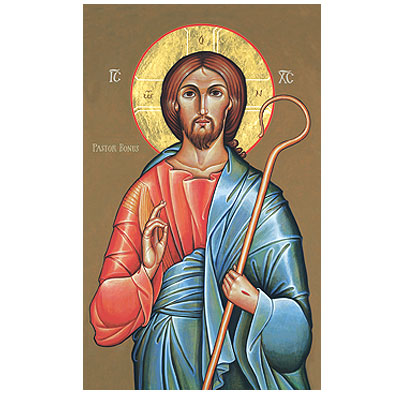

To the traditional iconographic image of Christ the Benefactor Br. Claude Lane, O.S.B. has added Biblical imagery of the Good Shepherd, drawn from St. John’s Gospel, chapter 10, and the 23rd Psalm. Jesus' hands show the wounds of the cross because the good shepherd lays down His life for His sheep (John 10:11). He holds a staff, or crosier, to indicate that He is the guardian of His flock. Many of us go through life feeling lost or without purpose, but this image helps us contemplate the Divine Compassion of God, “the guardian of our souls" (1 Peter 2:25).
Wood-mounted icons are on 5/8" ProWood® Medium Density Fiberboard (MDF) with a wood-look foil finish, with tee-slots milled in the back for easy hanging. Icons are finished in classic cherry to replicate the traditional icon red, in keeping with Byzantine tradition. (Ancient icon board edges were frequently coated with red bole, a form of clay). Each mounted icon comes with a descriptive pamphlet explaining the symbolism and history of the image.
Please allow 5-10 business days for orders of 20 or more icons.
Our icon designs are also available as unmounted prints in sanctuary-size enlargements up to 38 inches wide. The latest technology enables enlargement without sacrificing quality. We do not currently have the ability to mount these prints on wood or any other material. You may purchase your own frame from a custom frame shop. Call 800-889-0105 for pricing and ordering.
The imagery for this icon is taken from St. John’s Gospel in which Jesus describes himself as “The Good Shepherd,” (see John 10:11-16), and has allegorical roots in the familiar Psalm 23. It has been a popular image throughout Christian history but its artistic origins and ethos are found in pre-Christian, Greco-Roman culture. In various places, but especially in tombs, we find images of a man carrying a lamb on his shoulders —the good shepherd. It is a secular image representing universal benefaction to all peoples. It is thus no surprise then, that this concept and aesthetic form was later applied to Jesus. This particular icon departs from the secular Greco-Roman designs and combines a Christ the Benefactor motif (a form of the Christ Pantocrator, a common depiction in iconography) with shepherd imagery. The classic half-length, frontal view of the Savior with hand raised in blessing and a slight look of empathy in his expression is a classic iconographic style and indicative of the Benefactor. The image was written by Br. Claude Lane, OSB in 2001 as part of Mount Angel Abbey’s preparations for the election of a new abbot. It is used liturgically for the Solemnity of Christ the King (last Sunday before Advent), and on Good Shepherd Sunday (fourth Sunday after Easter)
Christ the Benefactor is a classic motif in iconography, and depicts a sympathetic Redeemer, rather than the more stern “Lord of All” found in similar Pantocrator images. In these icons Christ is shown with a hand raised in blessing. The two extended and lowered fingers denote the dual natures of Christ. Jesus’ red and blue clothing represent His “humanity cloaked in divinity.” The rather elongated face, thin nose and relatively large eyes create a mystical appearance that draws one in to the Holy Face. The circular strands of hair represent the endless flow of time. To this traditional image of Christ the Benefactor Br. Claude has added Biblical imagery of Jesus as the Good Shepherd. His hands show the wounds of the cross because the good shepherd lays down His life for His sheep (John 10:11). His staff is turned outward to indicate that He is the true Shepherd who knows his sheep. This out-turned crosier is an appropriate symbol for the newly elected abbot of Mount Angel Abbey because the abbot is recognized by his monks as the one who takes the place of Christ in their community and the true guardian of the flock. (Incidentally, visiting abbots turn their crosiers inward in deference to the abbot of the host community). St. Benedict uses pastoral imagery throughout The Rule when describing the abbot as “not driving the flocks too hard” and “entrusted to watch over the sheep.” Christ's halo, the iconographic symbol for sanctity, is inscribed with a cross (the nimbus) and the Greek letters omicron, omega, nu, spelling "HO ON." In English, this becomes "The Existing One," the second half of the name used for God in Exodus 3:14 which is traditionally translated from Hebrew to English as "I Am Who Am." The abbreviated Greek form of the name Jesus Christ, "IC XC,” appears around the head of Our Lord. The face is the “true icon” and thus the name appears there. Sometimes in life, we may feel lost or without purpose. This icon serves as a reminder that we are always looked after with a shepherd’s care. Christ knows His own sheep and lays down his life for them. In contemplating this holy image, God’s Divine Will and infinite compassion draw us closer to the Pastor Bonus who left the ninety-nine sheep to go after the one that was lost (see Luke 15:4).